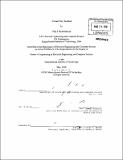| dc.contributor.advisor | Emilio Frazzoli. | en_US |
| dc.contributor.author | Oleg I. Kozhushnyan, Oleg I. Kozhushnyan (Oleg Igorevich) | en_US |
| dc.contributor.other | Massachusetts Institute of Technology. Dept. of Electrical Engineering and Computer Science. | en_US |
| dc.date.accessioned | 2011-02-23T14:23:18Z | |
| dc.date.available | 2011-02-23T14:23:18Z | |
| dc.date.copyright | 2010 | en_US |
| dc.date.issued | 2010 | en_US |
| dc.identifier.uri | http://hdl.handle.net/1721.1/61167 | |
| dc.description | Thesis (M. Eng.)--Massachusetts Institute of Technology, Dept. of Electrical Engineering and Computer Science, 2010. | en_US |
| dc.description | Cataloged from PDF version of thesis. | en_US |
| dc.description | Includes bibliographical references (p. 35). | en_US |
| dc.description.abstract | Traffic simulation is an important aspect of understanding how people move throughout various road systems. It can provide insight into the design of city streets and how well they can handle certain traffic patterns. There are various simulators available, ranging from free tools such as TRANSIMS to commercial implementations such as TransCAD. The available tools provide complex, large scale and very detailed simulation capabilities. The Virtual City Testbed addresses aspects that are not available in these tools. Primarily, the test bed provides the ability for interaction with the traffic system in real time. Instead of basing the simulation solely on automated vehicle models, we allow for human participants to interact with individual cars via a remote simulation client. Thus we are able to inject realistic human input into our simulation. A second feature provided by our simulation is the ability to disrupt a simulation in progress. A disruption usually involves disabling access to a set of streets which forces the traffic to adapt as it moves around the road system. This yields a way to study the way traffic motion changes within a road system under the presence of unexpected events such as natural disasters or other real life disruptions. Ultimately, we provide a test bed for studying traffic under varying environmental conditions. | en_US |
| dc.description.statementofresponsibility | by Oleg I. Kozhushnyan. | en_US |
| dc.format.extent | 35 p. | en_US |
| dc.language.iso | eng | en_US |
| dc.publisher | Massachusetts Institute of Technology | en_US |
| dc.rights | M.I.T. theses are protected by
copyright. They may be viewed from this source for any purpose, but
reproduction or distribution in any format is prohibited without written
permission. See provided URL for inquiries about permission. | en_US |
| dc.rights.uri | http://dspace.mit.edu/handle/1721.1/7582 | en_US |
| dc.subject | Electrical Engineering and Computer Science. | en_US |
| dc.subject.lcsh | Traffic flow Simulation methods | en_US |
| dc.title | Virtual city testbed | en_US |
| dc.type | Thesis | en_US |
| dc.description.degree | M.Eng. | en_US |
| dc.contributor.department | Massachusetts Institute of Technology. Department of Electrical Engineering and Computer Science | |
| dc.identifier.oclc | 699490832 | en_US |
